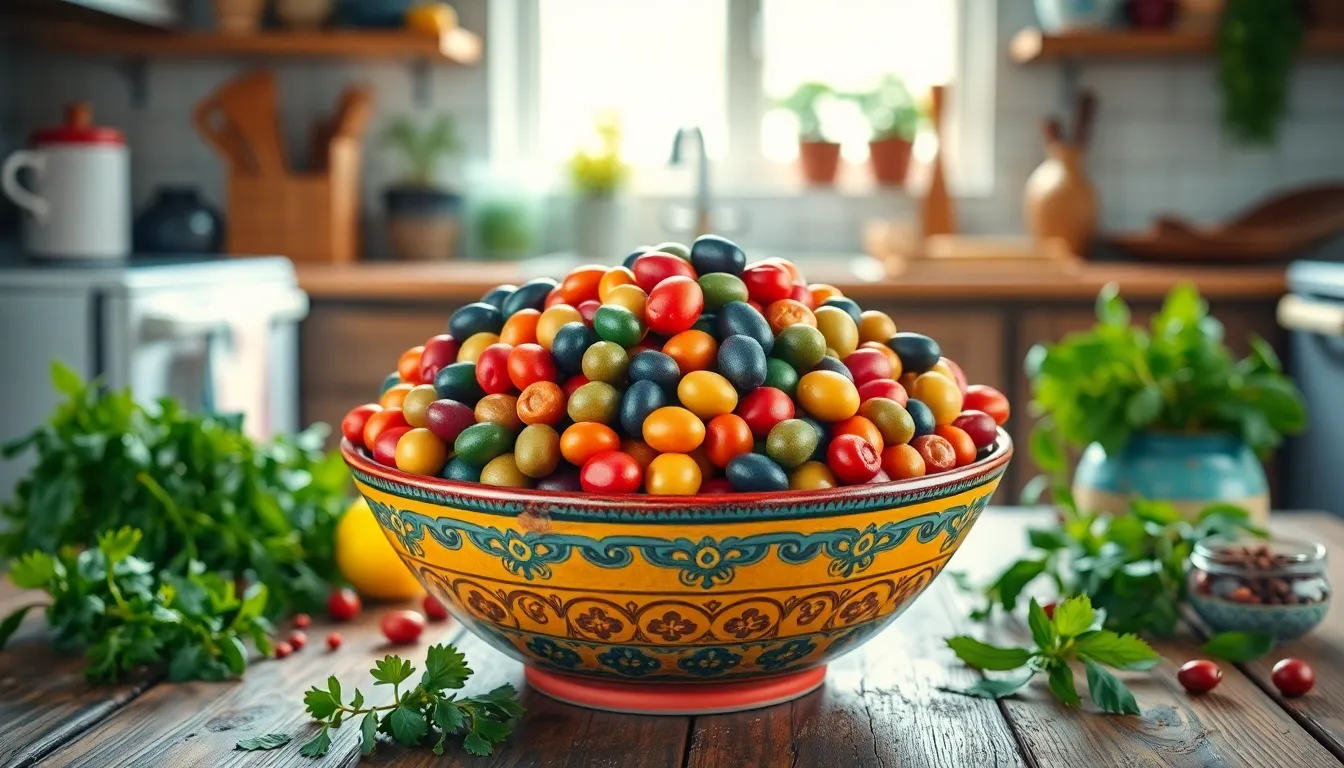In the culinary world, mastering the basics is just the beginning. Once you’ve conquered the art of boiling water and flipping pancakes without creating a kitchen disaster, it’s time to level up. Advanced cooking techniques can transform an ordinary meal into a gastronomic masterpiece that’ll have your friends thinking you’ve secretly trained with a Michelin-star chef.
Table of Contents
ToggleOverview of Advanced Cooking Techniques
Advanced cooking techniques enhance culinary creations and broaden a chef’s skill set. Sous vide involves cooking food in vacuum-sealed bags at precise temperatures, resulting in perfectly cooked dishes. This method guarantees consistency in texture and flavor, particularly for meats and vegetables.
Emulsification serves a crucial function in achieving smooth textures in sauces. Techniques like using a whisk or blender combine oil and vinegar effectively, allowing for stable mixtures like dressings. Mastery of emulsions can elevate simple recipes significantly.
Confit, a timeless technique, involves cooking food slowly in fat, which preserves flavor and moisture. Commonly used for meats and fruits, this method results in tender, flavorful dishes that last longer. It requires careful attention to cooking temperatures for optimal results.
Another technique, fermentation, introduces beneficial bacteria to ingredients, enhancing flavor and preserving food. Fermented products like kimchi and yogurt showcase this method’s versatility. The process not only improves taste but also contributes health benefits.
Searing creates a beautiful crust on meats while locking in juices, maximizing flavor. This high-heat technique requires skill and timing, ensuring the food cooks evenly.
Lastly, smoking introduces complex flavors to dishes. There are various methods, including cold and hot smoking, allowing for experimentation with different wood chips. This technique is popular for meats, fish, and vegetables alike.
Mastering these advanced techniques empowers home cooks to elevate their meals, transforming everyday ingredients into exceptional culinary experiences.
Sous Vide Cooking
Sous vide cooking offers precise control over temperature, ensuring consistent results. This technique allows home cooks to achieve restaurant-quality dishes with minimal effort.
Benefits of Sous Vide
Sous vide cooking provides several benefits that elevate culinary results. Precision in cooking temperature means foods cook evenly and retain natural juices. This method enhances flavor infusions, as the vacuum-sealed environment intensifies seasoning absorption. Texture improves significantly, resulting in meats that are tender and vegetables that maintain a perfect bite. Additionally, sous vide cooking minimizes the risk of overcooking, making it easier to achieve desired doneness, whether it’s perfectly medium-rare steak or delicate poached eggs.
Common Sous Vide Mistakes
Common mistakes often hinder the sous vide experience. Failing to remove air from bags can lead to uneven cooking, as water may not circulate effectively. Using incorrect temperatures causes undesirable results; for example, cooking chicken at too low a temperature can result in unsafe dinners. Overcrowding bags often prevents even heat distribution, leading to inconsistent outcomes. Ignoring appropriate cooking times may also result in food that’s either undercooked or overly soft. Lastly, neglecting to finish dishes with proper searing undermines the flavor and texture benefits achieved through sous vide.
Molecular Gastronomy
Molecular gastronomy combines science and cooking, utilizing chemical transformations to create unique textures and flavors. This innovative approach allows chefs to think creatively, presenting food in unexpected forms.
Essential Tools and Ingredients
Key tools in molecular gastronomy include a sous vide precision cooker, immersion blender, and food-grade syringes. Each tool serves a specific purpose, enhancing the cooking process. Spherification kits are crucial for creating spheres filled with liquid, while carbonation systems add fizzy elements to dishes. Essential ingredients often involve agar-agar, gelatin, and lecithin, which provide gelling and emulsifying properties. Understanding these tools and ingredients helps chefs elevate the culinary experience.
Techniques in Molecular Gastronomy
Various techniques define molecular gastronomy, each offering unique results. Spherification creates liquid-filled spheres, resembling caviar. Foaming introduces air into liquids, producing airy textures. Emulsification generates stable mixtures of oil and water, resulting in sauces with perfect consistency. Another technique involves gelification, which transforms liquids into gels, enhancing presentation. Each method encourages experimentation, pushing culinary boundaries in innovative ways.
Fermentation Techniques
Fermentation enhances flavors and preserves food by utilizing beneficial bacteria. This technique not only enriches the culinary experience but also provides health benefits.
Health Benefits of Fermented Foods
Fermented foods improve gut health due to their rich probiotic content. Probiotics promote healthy digestion, support immune function, and may help prevent certain illnesses. Regular consumption of fermented products can also increase nutrient absorption, making vitamins and minerals more bioavailable. Examples of fermented foods with significant health benefits include yogurt, sauerkraut, and kefir. These foods contribute to a balanced diet and can help alleviate digestive issues such as bloating. Research indicates that incorporating fermented foods can also enhance overall well-being and mental health.
Popular Fermentation Methods
Several fermentation methods are favored by culinary enthusiasts. Lacto-fermentation, which uses lactic acid bacteria, is popular for pickling vegetables. This method preserves the crunchiness and enhances the flavors of the ingredients. Another common technique is alcoholic fermentation, essential in brewing beer and making wine. In addition, carbon dioxide fermentation plays a crucial role in bread-making, creating the airy texture of loaves. Each method varies in process and ingredients but consistently results in distinctive flavors and improved shelf life. Understanding these methods enriches cooks’ abilities in the kitchen.
Smoking and Smoking Methods
Smoking adds depth and complexity to flavors, transforming dishes with unique profiles. Mastering various smoking techniques enhances the culinary experience.
Cold Smoking vs. Hot Smoking
Cold smoking occurs at temperatures below 90°F, allowing delicate foods like fish and cheese to absorb smoke flavors without cooking. This technique requires longer exposure to smoke, typically lasting several hours or even days. In contrast, hot smoking cooks food at temperatures ranging from 140°F to 250°F, creating tender, flavorful meats with a smoky crust. Hot smoking often takes a few hours, depending on the food being smoked. Both methods offer distinct flavors, appealing to different culinary preferences.
Choosing the Right Wood
Choosing the correct wood significantly impacts the flavor profile of smoked dishes. Fruitwoods such as apple and cherry provide a mild, sweet smoke, perfect for poultry and pork. On the other hand, hardwoods like hickory and mesquite deliver a stronger, bolder taste, ideal for beef and ribs. Utilizing aromatic woods such as cedar adds a unique twist to fish dishes. Mixing different woods can create layered flavors, enhancing the overall smoking experience. Understanding these options helps chefs achieve the desired flavor in their smoked creations.
Embracing advanced cooking techniques opens a world of culinary possibilities. Home cooks can transform their meals and impress guests with newfound skills. From the precision of sous vide to the creativity of molecular gastronomy each method offers unique flavors and textures that elevate dishes.
The journey into advanced cooking encourages experimentation and innovation. By mastering these techniques cooks not only enhance their culinary repertoire but also gain confidence in the kitchen. Whether it’s the art of fermentation or the depth of smoking these skills empower individuals to create exceptional dining experiences at home.




